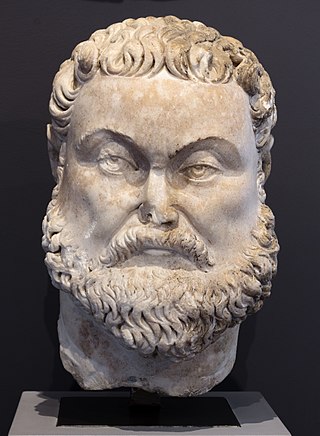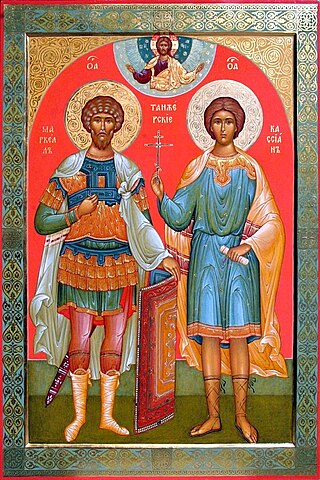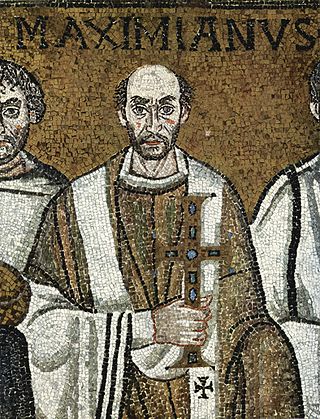Related Research Articles

Flavius Valerius Constantius, also called Constantius I, was a Roman emperor from 305 to 306. He was one of the four original members of the Tetrarchy established by Diocletian, first serving as caesar from 293 to 305 and then ruling as augustus until his death. Constantius was also father of Constantine the Great, the first Christian emperor of Rome. The nickname "Chlorus" was first popularized by Byzantine-era historians and not used during the emperor's lifetime.

Galerius Valerius Maximianus was Roman emperor from 305 to 311. While acting as Caesar under Emperor Diocletian, Galerius obtained victory warring against the Persian Sassanian Empire, defeating Narseh at the battle of Satala in 298 and possibly sacking the Sassanian capital of Ctesiphon in 299. He also campaigned across the Danube against the Carpi, defeating them in 297 and 300. Although he was a staunch opponent of Christianity, Galerius ended the Diocletianic Persecution when he issued the Edict of Toleration in Serdica (Sofia) in 311.

Maximian, nicknamed Herculius, was Roman emperor from 286 to 305. He was Caesar from 285 to 286, then Augustus from 286 to 305. He shared the latter title with his co-emperor and superior, Diocletian, whose political brain complemented Maximian's military brawn. Maximian established his residence at Trier but spent most of his time on campaign. In late 285, he suppressed rebels in Gaul known as the Bagaudae. From 285 to 288, he fought against Germanic tribes along the Rhine frontier. Together with Diocletian, he launched a scorched earth campaign deep into Alamannic territory in 288, refortifying the frontier.

The Praetorian Guard was the imperial guard of the Imperial Roman army that served various roles for the Roman emperor including being a bodyguard unit, counterintelligence, crowd control and gathering military intelligence.
Maximianus was the archbishop of Constantinople from 25 October 431 until his death on 12 April 434.
Saint Kyriaki, also known as Saint Kyriaki the Great Martyr, is a Christian saint, who was martyred under the emperor Diocletian.
The Roman imperial cult identified emperors and some members of their families with the divinely sanctioned authority (auctoritas) of the Roman State. Its framework was based on Roman and Greek precedents, and was formulated during the early Principate of Augustus. It was rapidly established throughout the Empire and its provinces, with marked local variations in its reception and expression.

Saint Marcellus of Tangier or Saint Marcellus the Centurion was a Roman centurion who is today venerated as a martyr-saint in both the Eastern Orthodox and the Catholic Church. His feast day is celebrated on October 30.

Maximianus of Ravenna, or Maximian was bishop of Ravenna in Italy. Ravenna was then the capital of the Byzantine Empire's territories in Italy, and Maximianus's role may have included secular political functions.

Viktor of Xanten was a 4th century martyr and saint recognized by the Roman Catholic Church and the Eastern Orthodox Church. Since the 12th century, his presumed bones have been kept in a shrine, which is embedded in the high altar of the Xanten Cathedral. His feast day is October 10.
Rictius Varus was a Vicarius in Roman Gaul at the end of the 3rd century, around the time of the Diocletianic Persecution. The Roman Martyrology contains many references to the prefect Rixius Varus, who is said to have persecuted hundreds of Christians. In Christian hagiography he later repented and became a Christian martyr himself, and is regarded a Saint in the Eastern Orthodox and Roman Catholic Churches, with his feast day on July 6.

Maurice was an Egyptian military leader who headed the legendary Theban Legion of Rome in the 3rd century, and is one of the favourite and most widely venerated saints of that martyred group. He is the patron saint of several professions, locales, and kingdoms.

The 20,000 Martyrs of Nicomedia refers to victims of persecution of Christians in Nicomedia, Bithynia by the Roman emperors Diocletian and Maximian in the early 4th century AD.

The history of the Roman Empire covers the history of ancient Rome from the traditional end of the Roman Republic in 27 BC until the abdication of Romulus Augustulus in AD 476 in the West, and the Fall of Constantinople in the East in 1453. Ancient Rome became a territorial empire while still a republic, but was then ruled by emperors beginning with Octavian Augustus, the final victor of the republican civil wars.
The Decian persecution of Christians occurred in 250 AD under the Roman Emperor Decius. He had issued an edict ordering everyone in the Empire to perform a sacrifice to the Roman gods and the well-being of the emperor. The sacrifices had to be performed in the presence of a Roman magistrate, and be confirmed by a signed and witnessed certificate from the magistrate. Although the text of the edict has been lost, many examples of the certificates have survived.

The civil wars of the Tetrarchy were a series of conflicts between the co-emperors of the Roman Empire, starting from 306 AD with the usurpation of Maxentius and the defeat of Severus to the defeat of Licinius at the hands of Constantine I in 324 AD.

Mercurius was a Roman soldier of Scythian descent who became a Christian saint and martyr. He was born in the city of Eskentos in Cappadocia, in Eastern Asia Minor. According to Christian tradition, he was the soldier who killed Julian the apostate during his campaign in Persia. Saint Mercurius was also widely known by his Arabic-language name Abu-Sayfain, Abu-Sifin or Abu-Sefein in Egyptian Arabic which means "father of two swords", referring to the second sword given to him by the Archangel Michael.

The Religious policies of Constantine the Great have been called "ambiguous and elusive." Born in 273 during the Crisis of the Third Century, Constantine the Great was thirty at the time of the Great Persecution. He saw his father become Augustus of the West and then shortly die. Constantine spent his life in the military warring with much of his extended family, and converted to Christianity sometime around 40 years of age. His religious policies, formed from these experiences, comprised increasing toleration of Christianity, limited regulations against Roman polytheism with toleration, participation in resolving religious disputes such as schism with the Donatists, and the calling of councils including the Council of Nicaea concerning Arianism. John Kaye characterizes the conversion of Constantine, and the Council of Nicea that Constantine called, as two of the most important things to ever happen to the Christian church.

The Conference of Carnuntum was a gathering of ancient Roman rulers on 11 November 308, intended to stabilize the power-sharing arrangement known as the Tetrarchy. It was convened by the Eastern augustus (emperor) Galerius in the city of Carnuntum, which at the time was located in the Roman province of Pannonia Prima. A dispute over the title of augustus in the West had been ongoing since the previous year, when consecutive invasions by Severus II and Galerius had failed to recover Italy from the usurpers Maxentius and Maximian. Present at the conference were the retired Diocletian, and his former colleague, Maximian.

Saint Maurice is an oil tempera on beech board painting by Bohemian painter Master Theodoric, created around 1360-1365. It is probably the first depiction of a black man in Czech painting. The extraordinary importance of this knight in the conception of the Chapel of the Holy Cross is evidenced by the portrait's placement in the main space of the presbytery adjacent to the painting of St. George and the Bohemian patron saint St. Vitus.
References
- 1 2 "San Tipasio di Tigrava", Santi e Beati, October 12, 2000
- ↑ Woods, David. "The Military Martyrs", UCC, April 2005
- ↑ Syrbe, Daniel. "Typasius the Veteran", University of Hamburg
- ↑ Adamiak, Stanislaw. "Martyrdom of Typasius", The Cult of Saints in Late Antiquity, University of Oxford, February 8, 2021
- ↑ (in Italian) Tipasio, Roman Martyrology, January 11